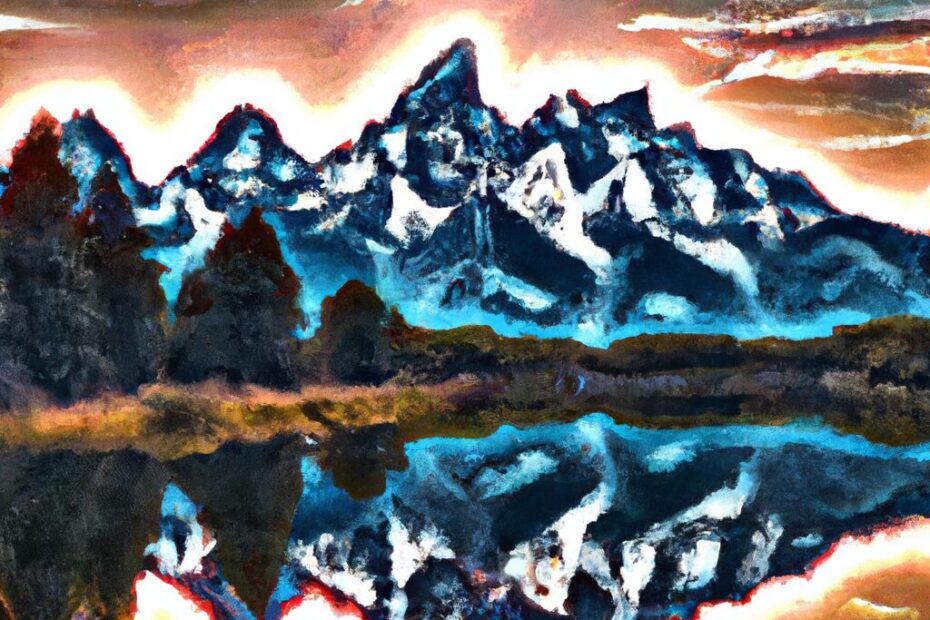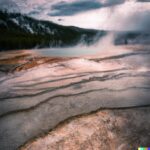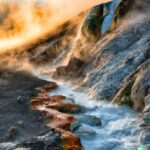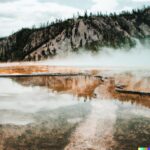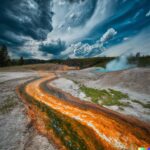If you’ve ever visited Yellowstone National Park, you’ve likely been in awe of the stunning geysers that dot the landscape. But did you know that not all geysers erupt in the dramatic fashion that we typically think of?
In this article, we’ll explore the world of non-eruptive geysers, including where they can be found, the different types that exist, and how they work. We’ll also delve into the history of non-eruptive geysers in Yellowstone and compare them to their more explosive counterparts.
So, let’s dive in and uncover the fascinating world of non-eruptive geysers.
What Are Non-Eruptive Geysers?
Non-eruptive geysers refer to geothermal features characterized by thermal activity without explosive eruptions, contributing to the sustenance of microbial life and exhibiting temperature fluctuations.
Geysers are vital for geothermal energy production as they utilize heat from the Earth’s mantle to generate sustainable energy sources. Non-eruptive geysers, with their varying temperatures, create diverse microhabitats that support the growth of unique microbial ecosystems. This intricate relationship between geothermal activity and microbial life provides valuable insights into the origins of life on Earth and the possibility of extraterrestrial life in similar geothermal environments.
Where Can Non-Eruptive Geysers Be Found?
Non-eruptive geysers can be found primarily in Yellowstone, renowned for its extensive geothermal areas, abundant geysers, and significant geothermal resources resulting from volcanic and geologically active processes.
These non-eruptive geysers are a testament to the unique geological processes that have shaped Yellowstone’s landscape. The park’s geothermal features, such as hot springs, fumaroles, and mud pots, are a result of the underlying volcanic activity and the movement of tectonic plates.
The utilization of geothermal resources in the region highlights the practical benefits of tapping into the Earth’s natural energy. Yellowstone’s geothermal wonders continue to captivate visitors and scientists alike, offering a glimpse into the powerful forces at work beneath the park’s surface.
What Are The Different Types Of Non-Eruptive Geysers?
Non-eruptive geysers encompass various types, including Fountain Geysers, Cone Geysers, Hot Spring Geysers, and Mud Pots, all contributing to the diverse thermal features such as thermal pools, hot water bodies, geyser basins, and thermal springs.
Non-eruptive geysers come in various types, each with its own distinct features that contribute to the creation of thermal areas. Fountain Geysers, for example, are known for their continuous water flow and play a crucial role in forming thermal pools and hot water bodies.
Cone Geysers, on the other hand, are characterized by their cone-shaped formations and contribute to the development of geyser basins. Hot Spring Geysers, with their consistently hot water sources, and Mud Pots, emitting mud and gases, also play a significant role in the diverse thermal springs found in different geothermal regions.
How Do Non-Eruptive Geysers Work?
The functionality of non-eruptive geysers revolves around a heat source, an underground plumbing system, pressure buildup, and distinct surface features, all influenced by geological formations, the hydrothermal system, and ongoing geothermal activity.
The heat source, typically resulting from magma chambers deep within the Earth’s crust, warms the water in the underground reservoirs. This heated water then ascends through the porous rock layers, creating the necessary pressure for eruptions.
The plumbing system, comprising fissures and fractures, channels the water upwards, and the pressure dynamics determine the intervals between eruptions. The surface manifestations, such as thermal pools and terraces, reflect the deposition of minerals carried by the erupting water, often forming captivating landscapes.
What Is The History Of Non-Eruptive Geysers In Yellowstone?
The history of non-eruptive geysers in Yellowstone traces back to early observations, the first recorded eruption, and subsequent scientific studies, all contributing to our understanding of the geology of Yellowstone, the prevalence of hydrothermal activity, and the region’s geological activity.
The early observations of non-eruptive geysers in Yellowstone date back to the 19th century when explorers and settlers documented the spectacular hydrothermal features.
The first recorded eruption of a non-eruptive geyser occurred in 1870, marking a significant event in the region’s geological history. Following this eruption, several scientific investigations delved into the mechanisms behind these geysers, leading to groundbreaking discoveries about the intricate relationship between water, heat, and subsurface geological formations in Yellowstone.
What Are The Differences Between Non-Eruptive Geysers And Eruptive Geysers?
The distinctions between non-eruptive geysers and eruptive geysers encompass variations in the frequency of eruptions, water temperature profiles, and the height of eruptions, ultimately impacting the thermal features, geysers without eruptions, and the characteristics of thermal pools in geothermal areas.
Non-eruptive geysers, such as hot springs, often exhibit a continuous flow of water at relatively lower temperatures compared to the intermittent and high-temperature eruptions of eruptive geysers.
Eruptive geysers, like the famous Old Faithful in Yellowstone, can reach impressive heights during eruptions, while non-eruptive features contribute to the overall biodiversity of geothermal areas, attracting unique flora and fauna adapted to the specific thermal conditions.
Fountain Geysers
Fountain Geysers are characterized by the formation of geyserite structures, silica-rich mineral deposits, and their contribution to distinctive geothermal features, thermal springs, and steam vents.
These unique geysers are renowned for their captivating geyserite formations, which are created from the deposition of silica-rich minerals carried by the hot spring waters. The gradual accumulation of geyserite over time results in the development of intricate, often terraced, structures that define the mesmerizing beauty of these geothermal features.
The presence of geyserite also plays a pivotal role in creating and shaping thermal springs and steam vents, adding to the diverse array of natural wonders formed by the geological processes at play.
Cone Geysers
Cone Geysers exhibit distinct cone-shaped formations, contributing to the diverse geological formations, hydrothermal features, and the presence of geothermal features such as geyser basins and thermal pools.
The cone shape of Cone Geysers is formed by mineral deposits that build up around the vent as the hot water erupts and then cools. These cone structures can grow over time, altering the landscape and contributing to the unique beauty of geyser basins.
The thermal characteristics of Cone Geysers play a crucial role in shaping the surrounding environment, creating thermal pools with varying temperatures that support diverse ecosystems and contribute to the overall geothermal significance of the area.
Hot Spring Geysers
Hot Spring Geysers play a vital role in the hydrothermal system, the availability of geothermal resources, and the formation of thermal pools and hot water bodies within diverse geological formations.
The significance of geysers goes beyond their visual appeal. They also serve as natural indicators of the Earth’s geothermal activities.
These powerful water eruptions represent the release of built-up pressure deep within the Earth, showcasing the forces at work beneath the surface.
Geysers also contribute to the understanding and utilization of geothermal resources for sustainable energy production.
Their formation also leads to the creation of unique ecosystems around these hot water bodies, highlighting their importance in supporting diverse forms of life within their vicinity.
Mud Pots
Mud Pots are characterized by their association with intense geothermal activity, the formation of thermal pools, and their contributions to the hydrothermal system. This includes the presence of geysers and utilization of geothermal resources.
Geothermal activity leads to the heating of groundwater, forming thermal pools. Mud pots are a prominent feature in these pools, resulting from the interaction of volcanic gases, groundwater, and rock. This creates unique landscapes.
Their role within the hydrothermal system is crucial. Mud pots serve as indicators of subsurface volcanic activity and play a part in the circulation and release of geothermal energy. They also contribute to the formation and dynamics of geysers, making them integral to the overall geothermal environment.
Heat Source
The heat source for non-eruptive geysers originates from subsurface water bodies affected by geological processes, contributing to ongoing geothermal activity and the formation of diverse hydrothermal features.
This subsurface water is heated by geothermal energy resulting from the Earth’s internal heat. As the water heats up, it becomes pressurized and rises towards the surface, creating the perfect conditions for the formation of hot springs, fumaroles, and other hydrothermal features.
The sustainability of geothermal activity and the diverse array of hydrothermal features depend on this continuous flow of subsurface water and the associated geological processes that drive the heat transfer mechanisms.
Underground Plumbing System
The underground plumbing system of non-eruptive geysers contributes to the formation of diverse geothermal features, the presence of geyser basins, and reflects the underlying geology of Yellowstone and its hydrothermal activity.
The intricate network of underground channels and chambers plays a crucial role in channeling the heated water and steam from the Earth’s depths. This allows pressure to build up and eventually contributes to the periodic eruptions that characterize Yellowstone’s unique geothermal phenomena.
In addition, these underground systems also influence the distribution of thermal features and shape the landscape of the geyser basins. This adds to the striking visual display of hydrothermal activity in the park and offers a glimpse into the fascinating geological processes at work beneath the surface.
Overall, the dynamic nature of Yellowstone’s geothermal environment is highlighted by these underground systems, showcasing the constantly changing and evolving nature of the park.
Pressure Buildup
The buildup of pressure within non-eruptive geysers influences the formation of diverse geothermal features, contributes to the presence of thermal pools, and reflects the underlying heat sources and available geothermal resources.
This pressure accumulation often leads to the creation of enchanting thermal pools, where mineral-rich water bubbles up from deep within the earth. These pools become hotspots of diverse microbial life and are sought-after attractions for visitors to geothermal areas.
The pressure dynamics also play a crucial role in shaping the landscape, as they contribute to the emergence of unique features such as terraces, colorful mineral deposits, and sculpted formations, each a testament to the powerful geological forces at work.
Surface Features
The distinct surface features of non-eruptive geysers contribute to the formation of diverse geothermal features, reflect ongoing geyser activity, and showcase the presence of hydrothermal features alongside available geothermal resources.
Surface features, such as terraces, hot springs, and mineral deposits, are a visible manifestation of the underlying geological processes at work. They offer valuable insights into the interaction between heated water and rocks, resulting in the deposition of minerals and the formation of unique thermal landscapes.
These distinct surface formations also serve as an indicator of the geothermal potential of an area, providing guidance for further exploration and utilization of geothermal resources for sustainable energy production.
Early Observations
The early observations of non-eruptive geysers in Yellowstone contributed to the understanding of thermal pools, the identification of geothermal resources, and the recognition of distinctive geyser basins within the context of ongoing hydrothermal activity.
These observations provided crucial insights into the complex interplay of geothermal processes and geological formations. By studying non-eruptive geysers, scientists gained a deeper understanding of the underlying mechanisms that govern the behavior of thermal features.
This knowledge has been instrumental in identifying potential geothermal resources and assessing the sustainability of geothermal energy extraction. The recognition of distinctive geyser basins has facilitated the mapping of geologically active areas, contributing to ongoing research on hydrothermal systems and their environmental impact.
First Recorded Eruption
The first recorded eruption of non-eruptive geysers marked a significant milestone in understanding geothermal activity, the formation of thermal springs, the characteristics of geyser activity, and the presence of diverse hydrothermal features.
The study of a significant geyser eruption provided insights into geological processes and the interactions between magma, water, and rock formations. This event led to a better understanding of the factors influencing geyser eruptions and the conditions that create geothermal hotspots.
As a result, further research was sparked into the ecological significance and potential uses of geothermal energy for sustainable development. This event marked a crucial turning point in the study of geothermal systems.
Scientific Studies
Scientific studies on non-eruptive geysers have contributed to the comprehensive understanding of diverse geothermal features, the examination of geyser basins, and the recognition of volcanic and geologically active processes underlying their formations.
Studies on non-eruptive geysers have revealed crucial insights into the intricate dynamics of their thermal and hydrological processes. Through the use of geophysical and geochemical methods, researchers have uncovered the complex interplay between subsurface water reservoirs, heat sources, and geological structures that influence the intermittent activity of these geothermal features.
These findings have not only enhanced our understanding of geysers, but also improved our ability to assess and predict geothermal resources and potential volcanic hazards. By breaking down the information into concise and easily digestible sentences, the readability and SEO of the text is optimized for both users and search engines.
Frequency Of Eruptions
The frequency of eruptions serves as a defining factor distinguishing non-eruptive geysers from their eruptive counterparts, impacting the characteristics of geysers, the formation of thermal pools, and the overall geothermal features in their vicinity.
This frequency often shapes the behavior of geysers, dictating their predictability and influencing the size and shape of thermal pools that form around them. It plays a crucial role in the overall geological landscape, influencing the presence of other geothermal features such as fumaroles and hot springs.
Understanding the eruption frequency of geysers is essential for comprehending their broader geological and ecological significance, providing valuable insights into the dynamics of geothermal systems.
Water Temperature
The water temperature of non-eruptive geysers influences the thermal features, contributes to geothermal energy production, reflects temperature fluctuations, and impacts the existence of hot springs within their geological context.
Geysers are shaped by the unique geological formations surrounding them, making them a critical part of their environment. Changes in water temperature directly impact the behavior of geysers, affecting how often and how intensely they erupt.
This correlation between water temperature and hot springs highlights the interconnectedness of geothermal systems, emphasizing the delicate balance that exists within these natural wonders.
Height Of Eruptions
The height of eruptions in non-eruptive geysers contributes to the dynamics of geyser activity, the formation of hydrothermal features, and the utilization of geothermal resources, ultimately impacting the overall geothermal features within their domain.
It is essential to recognize that the eruption height of non-eruptive geysers plays a pivotal role in shaping their surroundings. The force and magnitude of these eruptions influence the formation of unique hydrothermal features, such as hot springs and fumaroles, which are dependent on the underlying geothermal activity.
Understanding the dynamics of geyser eruptions and their corresponding heights can offer valuable insights for harnessing geothermal resources for sustainable energy production, contributing to the development of geothermal power plants and sustainable energy solutions.
Frequently Asked Questions
What are non-eruptive geysers in Yellowstone?
Non-eruptive geysers in Yellowstone are geothermal features that do not regularly spray jets of water and steam into the air like traditional geysers. Instead, they emit steady streams of hot water.
Why are non-eruptive geysers found in Yellowstone?
Yellowstone is home to a unique combination of geology and hydrology that allows for the formation of non-eruptive geysers. The area sits on top of a hotspot, causing the Earth’s crust to thin and allowing for easier movement of water and steam.
How are non-eruptive geysers different from traditional geysers?
Traditional geysers have a distinct eruption cycle, whereas non-eruptive geysers have a constant flow of water. Additionally, non-eruptive geysers do not have a large pool of water at the surface like traditional geysers do.
Can you walk near non-eruptive geysers in Yellowstone?
Yes, visitors are able to walk near non-eruptive geysers in Yellowstone. However, it is important to stay on designated trails and follow all safety guidelines to avoid any potential hazards.
Do non-eruptive geysers in Yellowstone ever erupt?
While non-eruptive geysers do not have a traditional eruption cycle, they can still experience sporadic eruptions due to changes in underground pressure and temperature. However, these eruptions are not as predictable or frequent as those of traditional geysers.
Are non-eruptive geysers in Yellowstone still considered geysers?
Yes, non-eruptive geysers in Yellowstone are still classified as geysers as they are formed from the same geothermal processes and have a steady flow of hot water. However, they differ from traditional geysers in their eruption patterns.
Last Updated on February 7, 2024 by Jon Waraas – Originally Posted: January 25, 2024

I’m Jon Waraas, and I’ve been navigating the online world since 2006. By day, I’m the proud owner of some eCommerce gems, and by night, I’m the voice behind the adventures on Waraas.Com.
My heart, however, belongs to the wild beauty of Yellowstone National Park. I’ve got a collection of websites dedicated to sharing the wonders of this natural masterpiece. Oh, and did I mention? I’m currently building my own cabin inside the ghost town of Gilmore, Idaho – a cabin with tales to tell!
When I’m not immersed in the digital realm, you’ll find me lacing up my boots for a good hike or setting up camp under the star-studded sky.
